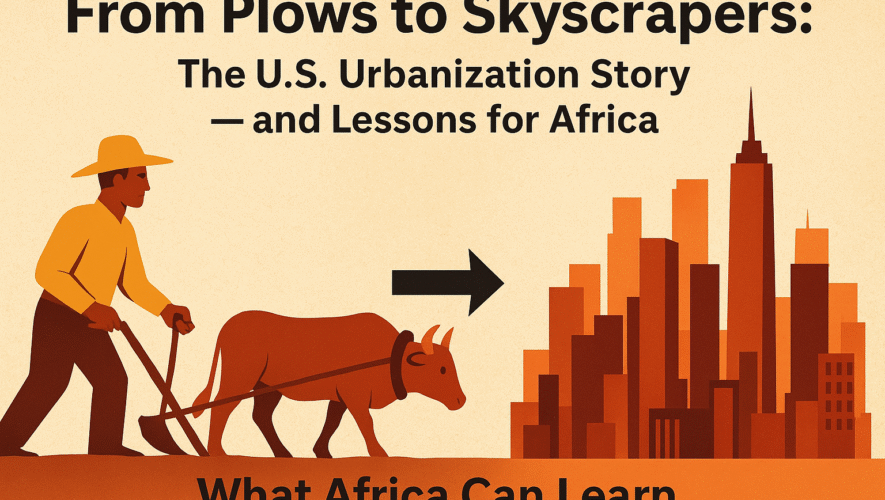From Plows to Skyscrapers: The U.S. Urbanization Story — and Lessons for Africa

When the United States was born in 1790, it was basically one big farm. 95% of Americans lived in rural areas, most working the land. By 2025, that figure is down to just 16%. In that time, America’s GDP per person jumped from about $2,400 to $75,000 (in today’s money). That’s a 30× leap in living standards — and urbanization was at the heart of it.
The Timeline of Change
- 1790–1850 – Overwhelmingly rural, but small industries and railroads start connecting towns. GDP per person rises slowly.
- 1860–1900 – Industrial revolution kicks in. Factories, railways, and mechanized farming pull workers to cities. Rural share drops from 80% to 60%. GDP per capita nearly doubles.
- 1920 – Urban majority for the first time: 51% city dwellers, 49% rural. This is when America’s economic growth truly accelerated.
- 1950–2000 – Massive urban expansion, suburbs, highways, and mass education fuel a middle-class boom. GDP per person soars from $18K to $50K.
- 2025 – 84% of Americans live in cities, working in services, tech, and finance. Agriculture is highly mechanized, producing more food with fewer workers.
What Africa Can Learn
- Urbanization Drives Productivity
Growth comes when labor moves to more productive sectors — industry, trade, and technology — rather than staying overwhelmingly in farming. - Infrastructure is the Bridge
Cities need roads, electricity, ports, and digital networks. Without them, urban migration can create congestion instead of opportunity. - Mechanize Agriculture
Modern farming frees workers to join higher-productivity sectors while maintaining food security. Africa can adopt technology in agriculture to multiply output. - Educate for the New Economy
Urban growth demands skilled workers. Universities, technical schools, and innovation hubs are essential to absorb rural migrants productively. - Manage the Social Shift
Rapid urban growth can produce slums and unemployment if unmanaged. Investment in housing, sanitation, and public services is crucial.
The Bottom Line:
Urbanization isn’t just about moving people into cities — it’s about creating economic engines where productivity, infrastructure, and innovation feed off each other. Africa’s urban growth is happening even faster than America’s did. The question is: will we harness it for prosperity, or let it spiral into chaos?
U.S. Rural vs Urban Population & GDP per Capita (1790–2025)
| Year | Total Pop. | Rural % | Rural Pop. | Urban % | Urban Pop. | GDP per Capita* (2023 USD) |
|---|---|---|---|---|---|---|
| 1790 | 3.9M | ~95% | ~3.7M | ~5% | ~0.2M | ~$2,400 |
| 1820 | 9.6M | ~93% | ~8.9M | ~7% | ~0.7M | ~$2,900 |
| 1850 | 23.2M | ~85% | ~19.7M | ~15% | ~3.5M | ~$4,200 |
| 1860 | 31.4M | ~80% | ~25.1M | ~20% | ~6.3M | ~$5,100 |
| 1880 | 50.2M | ~72% | ~36.1M | ~28% | ~14.1M | ~$6,500 |
| 1900 | 76.2M | ~60% | ~45.7M | ~40% | ~30.5M | ~$7,800 |
| 1920 | 106.0M | ~49% | ~51.0M | ~51% | ~55.0M | ~$10,200 |
| 1950 | 151.3M | ~36% | ~54.5M | ~64% | ~96.8M | ~$18,400 |
| 1970 | 203.3M | ~26% | ~52.9M | ~74% | ~150.4M | ~$29,200 |
| 2000 | 281.4M | ~21% | ~59.1M | ~79% | ~222.3M | ~$50,300 |
| 2020 | 331.4M | ~17% | ~56.3M | ~83% | ~275.1M | ~$69,300 |
| 2025** | ~341M | ~16% | ~54.6M | ~84% | ~286.4M | ~$75,000 |
From plows to skyscrapers: the U.S. went from 95% rural in 1790 to 84% urban in 2025, while GDP per person jumped 30×. The secret? Cities, industry, education, and mechanized farming. Africa is at the same crossroads: rapid urban growth is coming—will we harness it for prosperity or let it become chaos? Invest in infrastructure, modernize agriculture, skill your workforce, and let cities drive the future.



